Varieties and Types of Postage Stamps of the Austrian Empire
The Definitive Issue of 1850/54: Coat of Arms
Stamps were printed in printing sheets of 240 stamps which were then divided into 4 sheets, each having 60 stamps (8X8, 4 fields are St. Andrew crosses). Two types of paper were used. Stamps were first printed on a rough hand-made paper of uneven thickness with watermark in script letters K.K.H.M. (Kaiserlich Königliches Handels-Ministerium). The only 16-20 stamps out of 240 on a printing sheet are watermarked. From 1854 a smooth, thick machine paper without watermarks was used.
| TYPES |
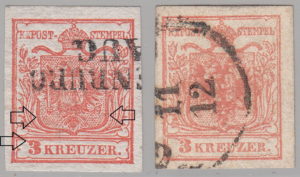
1 to 6 kreutzer: Types I and III
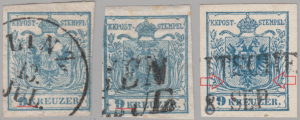
9 kreutzer stamp: Types I, II and III
More images:
2 kreutzer, Type I
6 kreutzer Type I, 6 kreutzer Type II |
Denominations from 1 to 6 kreutzer exist only in Types I and III. The 9 kreutzer stamps were printed in three types. All types exist on hand-made and on machine paper.
Type I:
- denomination value is touching the upper frame,
- the lower outline of the coat of arms consists of one thick line, only in cases of clear print this line appears to be split in two,
- in case of the 9 kreutzer stamp: the numeral 9 is standing lower than the inscription KREUTZER.
Type II (9 kreutzer only):
- coat of arms the same appearance as in Type I,
- the numeral 9 is about on a level of inscription KREUTZER.
Type III:
- denomination value is not touching the upper frame,
- the lower outline of the coat of arms consists of two lines.
Each type can be divided in subtypes. |
The Definitive Issue of 1858: Emperor Francis Joseph I facing to the left
Stamps were printed in letterpress with embossed profile of the Emperor. There were 240 stamps on a printing sheet, which were later divided into 4 sheets, each having 60 stamps (8X8, 4 fields with St. Andrew Crosses). Perforation comb 14½.
| TYPES |
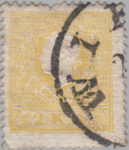 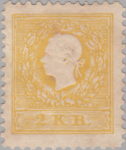
2 kreutzer: Types I and II
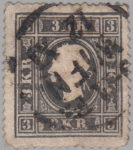 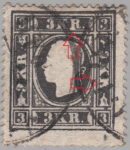
3 kreutzer stamp: Subtypes I and II
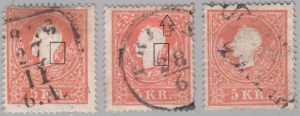
5 kreutzer: Type I, II and subtype IIa
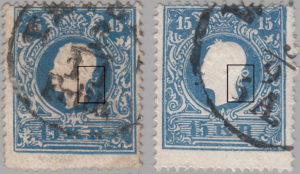
15 kreutzer: Types I and II |
TYPE I (1 November 1858):
- 2 kreutzer: foot of the numeral 2 thinning to the right,
- 3 to 15 kreutzer: the loop of the wreath at the back of the head is thin and broken.
There are 3 subtypes of the 3 kreutzer stamp of Type I:
- Subtype I: both letters R, on top and to the right normal.
- Subtype II: the letter R on top is touching the frame below, the loop of the letter R to the right is white.
- Subtype III: only the letter R on top is damaged, touching the frame below.
TYPE II (December 1858 – May 1859):
- 2 kreutzer: curved foot of uniform thickness,
- 3 to 15 kreutzer: the loop of the wreath is thick and enclosed,
- 5 kreutzer: the upper right frame is not broken.
There is one subtype of the 5 kreutzer stamp of Type II:
- Subtype IIa: the upper right frame is not broken.
|
| POSSIBLE CONSTANT VARIETIES (not mentioned in literature) |
| 15 Kreutzer |
| 1 |
White dot in the upper left corner.
Type II |
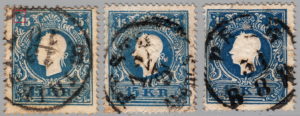 |
| 2 |
Hook of the numeral 1 in the upper left corner white.
Type II |
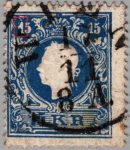 |
| 3 |
Numeral 5 in the upper left corner enclosed.
Type II |
 |
| 4 |
Thick horizontal line crossing the numeral 1 in the upper left corner.
Type I |
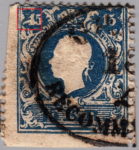 |
| 5 |
Sloping white line crossing the numeral 1 in the upper left corner.
Type II |
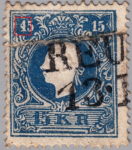 |
| 6 |
Numeral 1 in the upper left corner deformed.
Type II |
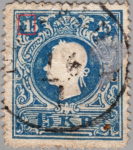 |
The Definitive Issue of 1860: Emperor Francis Joseph I facing to the right
Stamps were printed in letterpress with embossed profile of the Emperor. Perforation comb 14.
| POSSIBLE CONSTANT OR COINCIDENTAL VARIETIES (not mentioned in literature) |
| 5 kreutzer |
| 1 |
Lower part of the stamp poorly impressed. |
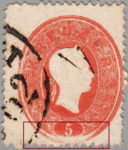 |
| 2 |
Lines of ornaments around medallion thicker or not visible, resulting in white areas. |
 |
| 15 kreutzer |
| 1 |
Ribbons of the laurel wreath connected. |
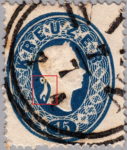 |
| 2 |
Letter E in KREUTZER deformed. |
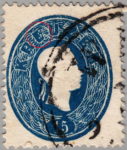 |
| 3 |
Lines of ornaments around medallion thicker or not visible, resulting in white areas. |
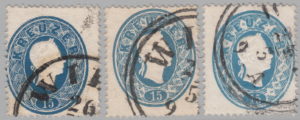 |
| COINCIDENTAL VARIETIES |
| 1 |
Perforation shifts. |
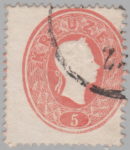 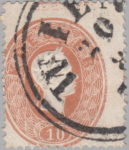 |
The Definitive Issue of 1863: Coat of Arms
Stamps were printed in letterpress, coat of arms embossed. Perforation comb 14.
| POSSIBLE CONSTANT VARIETIES (not mentioned in literature) |
| 5 kreutzer |
| 1 |
Lower right part of the stamp poorly impressed. |
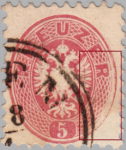 |
| 15 kreutzer |
| 1 |
White spot in letter K in KREUTZER. |
 |
| COINCIDENTAL VARIETIES |
| 1 |
Perforation shifts. |
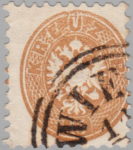 |
Austro-Hungarian Empire
Definitive issue of 1867, Emperor Francis Joseph I. facing to the right
The stamps were printed in letterpress on paper with watermark BRIEF-MARKEN. Perforation on 2 to 25 kreutzer stamps comb 9½, on 50 kreutzer stamp line 12.
| TYPES OF 5 KREUTZER STAMP |
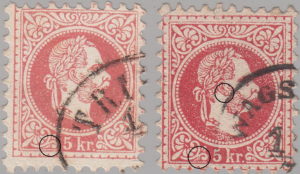
Coarse print Types Ia and Ib
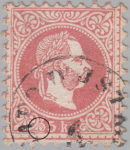
Coarse print Type II
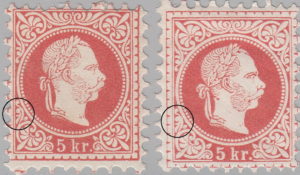
Fine print Types I and II |
Two different printing methods were used. The first produced stamps on which the lines are coarse and thick, from the second the lines are fine and thin. The prints can be best distinguished by Emperor’s hair. There are two types and two subtypes of stamps printed in coarse print and two types of stamps printed in fine print.
A. THE COARSE PRINT
Type I:
- the ornament next to the denomination number to the left is short,
- the flag of the number 5 is curvy and pointing upwards.
- Type Ia: lines in Emperor’s earlobe are detached and uninterrupted.
- Type Ib: the outer line of the earlobe is connected with the inner line by a red spot.
Type II:
- the ornament next to the denomination is prolonged within the curve,
- the flag of the numeral 5 is flat on top.
B. THE FINE PRINT
Type I:
- the small ornament next to the left frame detached.
Type II:
- the small ornament connected to the whole.
|
| COINCIDENTAL VARIETIES |
| 1 |
Perforation shifts. |
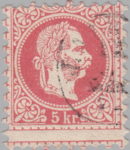 |
Newspaper stamps of 1867
The newspaper stamps depicting the Roman god Mercury were printed in letterpress in press sheets of 400 which were then cut in 4 sheets of 100 each (10×10). Imperforate.
| TYPES |
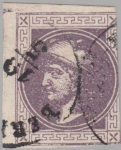
Type I, coarse print
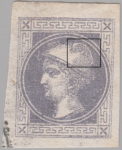 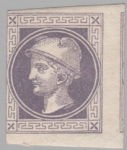
Type II, coarse and fine prints
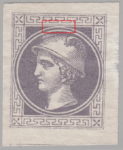 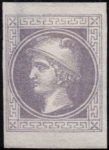
Types III and IIIa |
Stamps were printed in two printing methods which resulted in coarse and fine prints. Some of the types listed below can be found in both methods of print.
A. THE COARSE PRINT
Type I:
- helmet, head and the back of the neck not clearly separated from the background of the medallion,
- wing on the helmet only partly visible.
Type II:
- helmet, head and back of the head clearly separated from the background,
- the right wing on the helmet separated from the background with a white line,
- hair lines distinct.
B. THE FINE PRINT
Type I:
- helmet, head and the back of the neck clearly separated from the background,
- shading lines on the neck are not touching the background resulting in a white line separating the back of the neck from the medallion background.
Type II:
- helmet, head and back of the head clearly separated from the background,
- the right wing on the helmet separated from the background by a white line,
- hair lines distinct.
Type III:
- the outer white line of the medallion is open on top and joint with the horizontal white line.
Type IIIa:
- the outer white line of the medallion is enclosed.
|
| Possible constant varieties (not mentioned in literature) |
| 1 |
A circle in the medallion. |
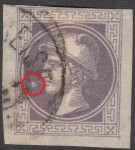 |
| 2 |
Big spot on the wing. |
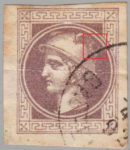 |
| 3 |
Small spot in front of the nose. |
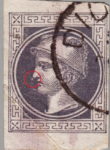 |
| 4 |
Bend at the left frame. |
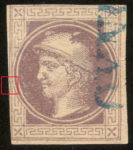 |
Definitive issue of 1883: Coat of Arms
Printed in sheets of 100 (10X10) on paper watermarked BRIEF-MARKEN or ZEITUNGS-MARKEN. Perforations comb 9½ (1883), line 9 (1883/84), line 10½ (1883/84), comb 10 (1887), line 11½: 12 : 12½ (1890) and combined.
No varieties are mentioned in literature, however, some were found and are presented in the table below.
| POSSIBLE CONSTANT VARIETIES (not mentioned in literature) |
| 2 kreutzer |
| 1 |
Letter i in Königl. broken. |
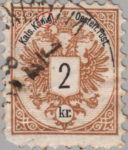 |
| 2 |
Letter t in Oesterr. broken. |
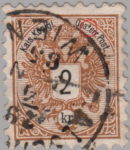 |
| 3 kreutzer |
| 1 |
Letter l in Königl. broken – Königi. |
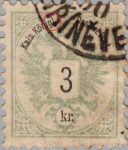 |
| 2 |
Letter K in Kais. short and deformed. |
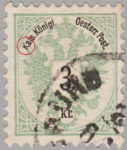 |
| 3 |
Letter k in kr. broken and deformed. |
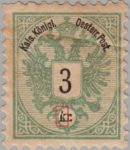 |
| 4 |
Letter t in Post. shorter, dot missing. |
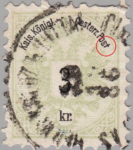 |
| 5 |
Letter n in Königl. partially missing. |
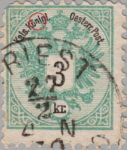 |
| 6 |
Horizontal line in letter ö in Königl. |
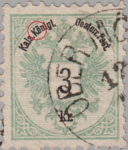 |
| 7 |
Leter k in kr. without serifs on top. |
 |
| 5 kreutzer |
| 1 |
Letter P in Post. flat on top. |
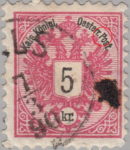 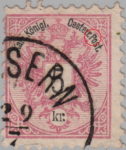 |
| 2 |
Letter e in Oesterr. enclosed – O8sterr. |
 |
| 3 |
Letter K in Kais. indented at the bottom. |
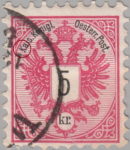 |
| 4 |
Letter t in Post. deformed. |
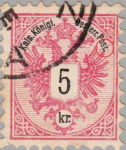 |
| 5 |
Letter O in Oesterr. open on top – Uesterr. |
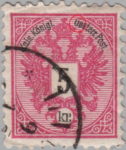 |
| 6 |
Letters i and s in Kais. connected with a black line. |
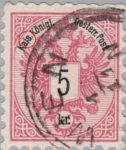 |
| 7 |
Letters e and s in Oesterr. damaged on top. |
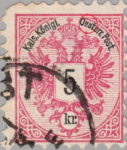 |
| 8 |
Comma instead of a dot after Königl. |
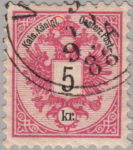 |
| 9 |
Black dot between letters K and a in Kais. |
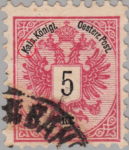 |
| 10 |
Letter k in kr. damaged at the bottom. |
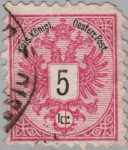 |
| 10 kreutzer |
| 1 |
Letter k in kr. damaged at the top. |
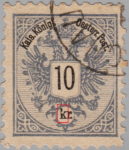 |
| 2 |
Letter O in Oesterr. broken at the bottom. |
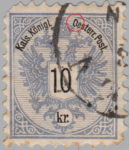 |
| 3 |
Letter O in Oesterr. broken at the top right. |
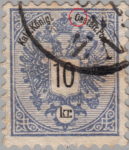 |
| 4 |
Letter O in Oesterr. broken at the bottom left. |
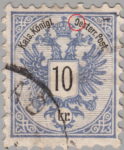 |
| 5 |
Letter l in Königl. short. |
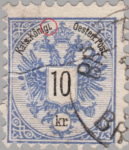 |
Definitive issue of 1908/1913: 60th year of the reign of Emperor Francis Joseph
Values of 1h-35h were printed in typography on two types of papers: ordinary and chalk surfaced. Values 50h-10K were printed in line engraving on grayish paper.
| CONSTANT VARIETIES |
| 25 heller |
| I |
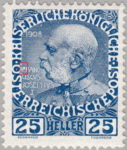 |
White spot on letter F in FRANCISCUS – PRANCISCUS. |
| 35 heller |
| I |
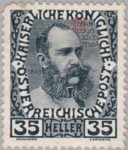 |
Additional horizontal line on letter F in FRANCISCUS – ERANCISCUS. |
Newspaper Stamps
1 June 1890: Coat of Arms
| POSSIBLE CONSTANT VARIETIES OR TYPES (not mentioned in literature) |
| 1 |
Colored spot between letters I and G in KÖNIG. |
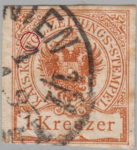 |
| 2 |
Letter K in KAIS broken in the middle. |
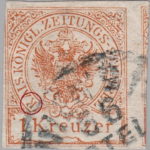 |
| 3 |
Letter e in Kreutzer open. |
 |
| 4 |
Colored spot between letters U and N in ZEITUNGS. |
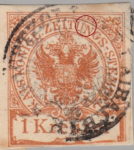 |
| 5 |
Top right part of the letter U in ZEITUNGS broken. |
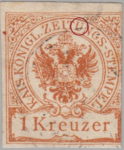 |
| 6 |
Letter K in Kreutzer broken in the middle. |
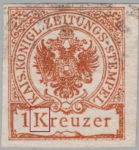 |
Bibliography
-
- ANK “Austria” Netto – Katalog, 42. Auflage 1987/88, ASCAT
- Michel Österreich-Spezial 2011, Schwaneberger Verlag GmbH, ISBN-13: 978-3878585923






































































